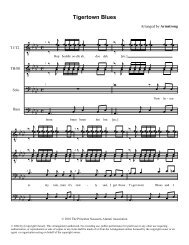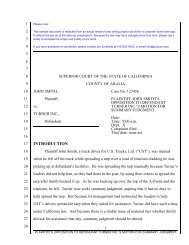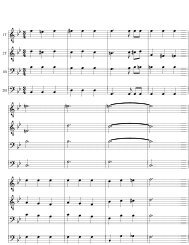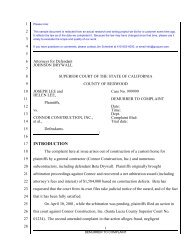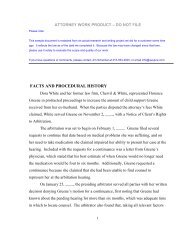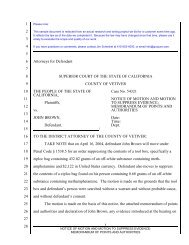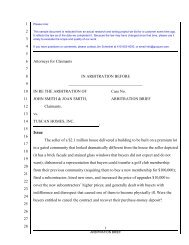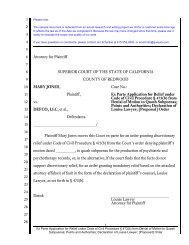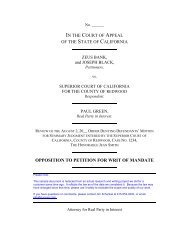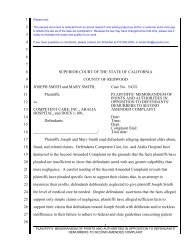Motion for Summary Judgment and/or Summary Adjudication
Motion for Summary Judgment and/or Summary Adjudication
Motion for Summary Judgment and/or Summary Adjudication
Create successful ePaper yourself
Turn your PDF publications into a flip-book with our unique Google optimized e-Paper software.
1<br />
2<br />
3<br />
4<br />
5<br />
6<br />
7<br />
8<br />
9<br />
10<br />
11<br />
12<br />
13<br />
14<br />
15<br />
16<br />
17<br />
18<br />
19<br />
20<br />
21<br />
22<br />
23<br />
24<br />
25<br />
26<br />
27<br />
28<br />
Code § 806. The grant’s language determines the easement’s scope. Pacific Gas & Elec.<br />
Co. v. Hacienda Mobile Homes Park (1975) 45 Cal.App.3d 519, 525.<br />
2. The parties to the Agreement intended that the reciprocal easements<br />
would survive the property’s transfer.<br />
Easements are property rights <strong>and</strong>, where appurtenant to l<strong>and</strong>, are transferrable <strong>and</strong><br />
descendible. See 2 REST.3D, PROPERTY (Servitudes) § 5.1 et seq. Transfers may be<br />
express <strong>or</strong> by implication, as where l<strong>and</strong> is transferred <strong>and</strong> all appurtenant easements are<br />
deemed to go with the grant without express mention. Civ. Code § 1104; Shonafelt v.<br />
Busath (1944) 66 Cal.App.2d 4, 14. Because of the difficulties involved in identification<br />
of the success<strong>or</strong> to an easement in gross, an easement is presumed appurtenant to l<strong>and</strong> of<br />
the owner. Balestra v. Button (1942) 54 Cal.App.2d 192, 197.<br />
When the language of a deed <strong>or</strong> grant is ambiguous, <strong>f<strong>or</strong></strong> example, as to whether <strong>or</strong><br />
not an easement is intended to be appurtenant to l<strong>and</strong>, extrinsic evidence is admissible to<br />
ascertain the parties’ intent. See Continental Baking Co. v. Katz (1968) 68 Cal.2d 512,<br />
522. The primary object of all contract interpretation is to ascertain <strong>and</strong> carry out the<br />
parties’ intention. City of Manhattan Beach v. Sup. Ct. (1996) 13 Cal.4th 232, 238.<br />
Where extrinsic evidence is received in interpretation of a grant of easement, but there is<br />
no conflict in the evidence, the instrument’s interpretation becomes a question of law.<br />
McManus v. Sequoyah L<strong>and</strong> Assoc. (1966) 240 Cal.App.2d 348, 353.<br />
In this case, when the adjoining l<strong>and</strong>owners executed the Agreement in 2___, they<br />
intended to create valid, binding, reciprocal easements that conveyed to each property<br />
owner a right of ingress <strong>and</strong> egress over the adjoining property of the others. And they<br />
intended that each property owner would be obligated to maintain that p<strong>or</strong>tion of the<br />
easement, which consisted of an unimproved dirt Road, that passed over their respective<br />
parcels. The parties also intended that each property owner would refrain from creating<br />
4<br />
NOTICE OF MOTION AND MOTION FOR SUMMARY JUDGMENT OR SUMMARY ADJUDICATION;<br />
PLAINTIFF’S MEMORANDUM OF POINTS AND AUTHORITIES



